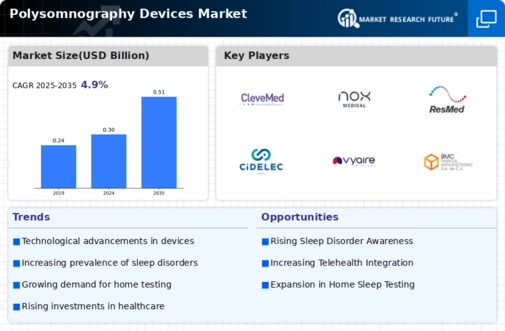Market Analysis
In-depth Analysis of Polysomnography Devices Market Industry Landscape
The growth and dynamics of polysomnography devices are influenced by many different factors. A diagnostic tool for sleep patterns and identification of a sleep disorder is known as polysomnography or PSG. The market, which includes these devices, is marked by several drivers, challenges, trends, and opportunities.
One of the main causes of the Polysomnography Devices market is rising incidence rate of sleeping disorders globally. As public awareness on the effect of lack of sleep on general health increases so does the number of people searching for diagnostic solutions to this effect; hence increasing demand for polysomnography devices. Consequently, increased instances like obstructive sleep apnea (OSA) and insomnia contribute to development of this industry since they require accurate diagnosis to ensure treatment is effective.
Technological advances play a crucial role in shaping market dynamics for polysomnography devices. Improved sensors technology, data analysis algorithms and user interfaces facilitate better functioning and reliability of these machines. Wireless capabilities integration and cloud-based platforms provide remote monitoring and data analysis that become convenient services to patients as well as healthcare providers. Therefore, manufactures have been putting emphasis on developing more user-friendly portable gadgets as home-based sleep studies are becoming increasingly common.
Despite its strong performance in providing patient support other challenges exist within the market with one major drawback being high-costs tied to performing polysomnography procedures. On its part PSG’s comprehensive nature demands trained experts to interpret information leading to high costs incurred in total participation. This factor may limit accessibility particularly within regions where financial positions are not very stable or having limited medical care facilities. Availability of alternative diagnostic methods such as home sleep apnea tests present a competitive threat towards normal polysomnography appliances though.
The use of ambulatory or portable sleep monitoring devices is an important trend in the Polysomnography Devices Market. These small wearable devices allow patients’ natural comfortable good nights’ sleeps hence possibly giving more accurate information for diagnosis. This shift towards ambulatory monitoring is in line with the growing preference for home-based healthcare solutions, which reduces sleep clinics’ need for overnight stays.
However, according to market dynamics it means that partnerships and alliances among major players are very important. The idea behind this is that companies are now forming strategic alliances to ride on each other’s technology, distribution channels and market presence. Joint venture or mergers and acquisitions are some of the common ways used to consolidate the industry share and encourage innovation on polysomnography devices.
From a geographical perspective, Polysomnography Devices market has diverse dynamics. North America leads the way as a region where there is a well-established health care infrastructure and a high prevalence of sleep disorders. Europe follows due to increasing awareness and proactive approach towards management of sleep related concerns. However, Asia pacific has been experiencing rapid growth due to increased public awareness of sleeping disorders coupled with better healthcare facilities besides middle-class population explosion.













Leave a Comment